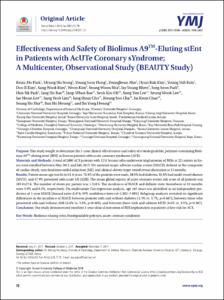KUMEL Repository
1. Journal Papers (연구논문)
1. School of Medicine (의과대학)
Dept. of Internal Medicine (내과학)
Effectiveness and Safety of Biolimus A9™-Eluting stEnt in Patients with AcUTe Coronary sYndrome; A Multicenter, Observational Study (BEAUTY Study).
- Keimyung Author(s)
- Hur, Seung Ho; Son, Chang Nam
- Department
- Dept. of Internal Medicine (내과학)
- Journal Title
- Yonsei Medical Journal
- Issued Date
- 2018
- Volume
- 59
- Issue
- 1
- Abstract
- PURPOSE:
This study sought to determine the 1-year clinical effectiveness and safety of a biodegradable, polymer-containing Biolimus A9™-eluting stent (BES) in Korean patients with acute coronary syndrome (ACS).
MATERIALS AND METHODS:
A total of 1000 ACS patients with 1251 lesions who underwent implantation of BESs at 22 centers in Korea were enrolled between May 2011 and July 2013. We assessed major adverse cardiac events (MACE) defined as the composite of cardiac death, non-fatal myocardial infarction (MI), and clinical-driven target vessel revascularization at 12 months.
RESULTS:
Patient mean age was 62.6±11.4 years. 72.8% of the patients were male, 28.5% had diabetes, 32.8% had multi-vessel disease (MVD), and 47.9% presented with acute MI (AMI). The mean global registry of acute coronary events risk score of all patients was 103.0±27.6. The number of stents per patient was 1.3±0.6. The incidences of MACE and definite stent thrombosis at 12 months were 3.9% and 0.2%, respectively. On multivariate Cox-regression analysis, age ≥65 years was identified as an independent predictors of 1-year MACE (hazard ratio=2.474; 95% confidence interval=1.202-5.091). Subgroup analyses revealed no significant differences in the incidence of MACE between patients with and without diabetes (4.3% vs. 3.7%, p=0.667), between those who presented with and without AMI (4.4% vs. 3.4%, p=0.403), and between those with and without MVD (4.6% vs. 3.5%, p=0.387).
CONCLUSION:
Our study demonstrated excellent 1-year clinical outcomes of BES implantation in patients at low-risk for ACS.
- Publisher
- School of Medicine (의과대학)
- Citation
- Keun-Ho Park et al. (2018). Effectiveness and Safety of Biolimus A9™-Eluting stEnt in Patients with AcUTe Coronary sYndrome; A Multicenter, Observational Study (BEAUTY Study). Yonsei Medical Journal, 59(1), 72–79. doi: 10.3349/ymj.2018.59.1.72
- Type
- Article
- ISSN
- 0513-5796
- Appears in Collections:
- 1. School of Medicine (의과대학) > Dept. of Internal Medicine (내과학)
- 파일 목록
-
-
Download
 oak-2018-0428.pdf
기타 데이터 / 730.16 kB / Adobe PDF
oak-2018-0428.pdf
기타 데이터 / 730.16 kB / Adobe PDF
-
Items in Repository are protected by copyright, with all rights reserved, unless otherwise indicated.